Our spring treatment consists of Extended Life Fertilizer (ELF) with pre-emergent crabgrass control. ELF is formulated to last about 6 months, and it’s applied at a high rate, so it will feed your lawn through the spring and summer gradually, and lasts until fall. Using ELF costs more than using conventional fertilizers, and our summer visit prices are reduced since we don’t need to fertilize. We believe that using Extended Life Fertilizer is better for your lawn, and better for our environment, because it results in less fertilizer runoff.
Frequently Asked Questions
Why does your first application cost so much more than your other visits?
How do I pay for your service?
Most customers pay per visit after each treatment, but we also offer a discounted prepayment option at the beginning of each year. We leave an invoice with each visit along with an envelope to mail it back to us with payment. Check or credit card is accepted.
How long should I wait to mow?
We recommend waiting at least until the following day to mow whenever we are applying broadleaf weed control, which is most of the time. These products work systemically and need this time to work effectively.
Should I bag my clippings when I mow?
As a general rule we recommend that you don’t ever bag your clippings, but especially for the first two cuttings after our treatments. Leaving the lawn clippings will recycle nutrients back to feed the lawn, and bagging the clippings following our visit can lessen the effectiveness of some of our treatments. This is most important following our spring treatment.
How often should I mow?
Mowing frequency should depend on how fast the lawn is growing, so in the spring you should usually be mowing more frequently. Each time you cut you should be removing 1/3 of the grass blade. Proper mowing frequency and cutting height (2.5-3.0 inches) are extremely important to keep your lawn looking its best. A sharp mower blade is also important.
When can my children and pets play in the lawn after the treatment?
Our recommendations follow the guidelines on the product labels. You should avoid going on the lawn until the application is completely dry. Normally this is less than an hour. It will vary with temperature and humidity.
